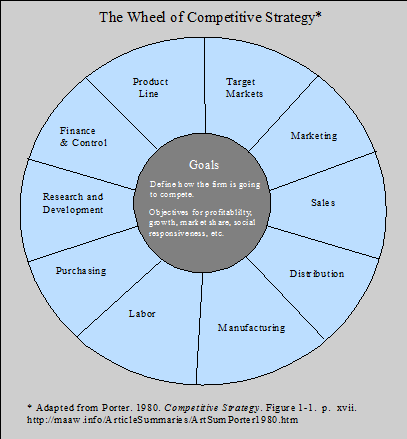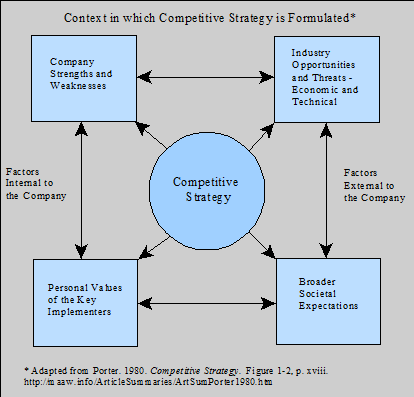
Preface, Introduction, and Links to Chapter Summaries 1-16
Summary by James R. Martin, Ph.D., CMA
Professor Emeritus, University of South Florida
Strategy Main Page | Balanced Scorecard Main Page
Porter explains how the book grew out of his research and teaching at the Harvard Business School, the motivation for the book, and also mentions the groups and individuals who helped make the book possible. His motivation for the book was essentially the lack of research addressed to the concerns of business managers and the subsequent need for more information and analytical techniques to help practitioners and scholars understand competition and competitive strategy.
Every firm has a competitive strategy although some strategies are implicit rather than explicit. However, there are significant benefits available to firms that engage in the explicit process of developing a strategy. This book presents a comprehensive framework for analyzing a firm's industry, its competitors, and its own position so that it can develop a competitive strategy.
Part I provides a framework for analyzing the structure of an industry (five competing forces), and its competitors.
Part II shows how to develop a competitive strategy using the framework described in Part I.
Part III completes the framework by examining various types of strategic decisions such as vertical integration, capacity expansion, and entering new businesses.
Porter provides four figures to illustrate and review the classic approach to the formulation of strategy. Figure 1-1, shows what he refers to as the wheel of competitive strategy. The hub shows the firm's goals, mission, or objectives. The spokes represent the firm's key operating policies. Like a wheel, the policies (spokes) must be connected to each other and reflect the goals of the firm (the hub).

Figure 1-2 includes the four factors that determine what the firm can successfully accomplish. On the left hand side, the firm's strengths and weaknesses are related to its assets and skills. These together with the personal values of the firm's key members (implementers) determines the limits to competitive strategy from an internal perspective. On the right-hand side, the industry environment together with broad societal factors (government policy, social concerns, etc.) determines the firm's external limits.

Figure 1-3 provides a list of questions to test the firm's goals and policies for internal consistency (e.g., Are the goals mutually achievable?), environmental fit (e.g., Do the goals and policies exploit industry opportunities), resource fit (e.g., Do the goals and policies match the resources available to the firm relative to competitors), and communication and implementation (Are the goals well understood by the key implementers?).
Figure 1-4 provides three main groups of questions related to the process of formulating a competitive strategy.
Group A: What is the business doing now? (Identification, and assumptions).
Group B: What is happening in the environment? (Industry, competitors, societal, and strengths and weaknesses).
Group C: What should the business be doing? (Test assumptions and strategy, strategy alternatives, strategic choice).
The purpose of the book is to show how to answer these questions.
__________________________________________________
Go to Chapter 1: The Structural Analysis of Industries
Related summaries:
Christensen, C. M. 1997. Making strategy: Learning by doing. Harvard Business Review (November-December): 141-142, 144, 146, 148, 150-154, 156. (Summary).
Clinton, B. D. and A. H. Graves. 1999. Product value analysis: Strategic analysis over the entire product life cycle. Journal of Cost Management (May/June): 22-29. (Summary).
De Geus, A. 1999. The living company. Harvard Business Review (March-April): 51-59. (Summary).
Fonvielle, W. and L. P. Carr. 2001. Gaining strategic alignment: Making scorecards work. Management Accounting Quarterly (Fall): 4-14. (Summary).
Gadiesh, O. and J. L. Gilbert. 2001. Transforming corner-office strategy into frontline action. Harvard Business Review (May): 72-79. (Summary).
Gosselin, M. 1997. The effect of strategy and organizational structure on the adoption and implementation of activity-based costing. Accounting, Organizations and Society 22(2): 105-122. (Summary).
Iansiti, M. and R. Levien. 2004. Strategy as ecology. Harvard Business Review (March): 68-78. (Summary).
Johnson, M. W., C. M. Christensen and H. Kagermann. 2008. Reinventing your business model. Harvard Business Review (December): 50-59. (Summary).
Kaplan, R. S. and D. P. Norton. 1996. Using the balanced scorecard as a strategic management system. Harvard Business Review (January-February): 75-85. (Summary).
Kaplan, R. S. and D. P. Norton. 2000. Having trouble with your strategy? Then map it. Harvard Business Review (September-October): 167-176. (Summary).
Kaplan, R. S. and D. P. Norton. 2001. Transforming the balanced scorecard from performance measurement to strategic management: Part I. Accounting Horizons (March): 87-104. (Summary).
Kaplan, R. S. and D. P. Norton. 2001. Transforming the balanced scorecard from performance measurement to strategic management: Part II. Accounting Horizons (June): 147-160. (Summary).
Kaplan, R. S. and D. P. Norton. 2004. Measuring the strategic readiness of intangible assets. Harvard Business Review (February): 52-63. (Summary).
Kim, W. C. and R. Mauborgne. 1997. Value innovation: The strategic logic of high growth. Harvard Business Review (January-February): 103-112. (Summary).
Kim, W. C. and R. Mauborgne. 1999. Creating new market space: A systematic approach to value innovation can help companies break free from the competitive pack. Harvard Business Review (January-February): 83-93. (Summary).
Kim, W. C. and R. Mauborgne. 2002. Charting your company's future. Harvard Business Review (June): 77-83. (Summary).
Kim, W. C. and R. Mauborgne. 2004. Blue ocean strategy. Harvard Business Review (October): 76-84. (Summary).
Kim, W. C. and R. Mauborgne. 2009. How strategy shapes structure. Harvard Business Review (September): 72-80. (Summary).
Kim, W. C. and R. Mauborgne. 2015. Red ocean traps: The mental models that undermine market-creating strategies. Harvard Business Review (March): 68-73. (Summary).
Langfield-Smith, K. 1997. Management control systems and strategy: A critical review. Accounting, Organizations and Society 22(2): 207-232. (Summary).
Luehrman, T. A. 1998. Strategy as a portfolio of real options. Harvard Business Review (September-October): 89-99. (Summary).
Magretta, J. 2002. Why business models matter. Harvard Business Review (May): 86-92. Explains the difference between a business model and a competitive strategy. (Summary).
Malone, D. and M. Mouritsen. 2014. Change management: Risk, transition, and strategy. Cost Management (May/June): 6-13. (Summary).
Martin, J. R. Not dated. What is a learning curve? Management And Accounting Web. LearningCurveSummary.htm
Martin, J. R. Not dated. What are economies of scale? Management And Accounting Web. EconomiesOfScaleNote.htm
O'Clock, P. and K. Devine. 2003. The role of strategy and culture in the performance evaluation of international strategic business units. Management Accounting Quarterly (Winter): 18-26. (Summary).
O'Reilly, C. A. III. and M. L. Tushman. 2004. The ambidextrous organization. Harvard Business Review (April): 74-81. (Summary).
Porter, M. E. 1987. From competitive advantage to corporate strategy. Harvard Business Review (May-June): 43-59. (Summary).
Porter, M. E. 1996. What is a strategy? Harvard Business Review (November-December): 61-78. (Summary).
Porter, M. E. 2001. Strategy and the internet. Harvard Business Review (March): 63-78. (Summary).
Porter, M. E. and M. R. Kramer. 2006. Strategy and society: The link between competitive advantage and corporate social responsibility. Harvard Business Review (December): 78-92. (Summary).
Reeves, M., C. Love and P. Tillmanns. 2012. Your strategy needs a strategy. Harvard Business Review (September): 76-83. (Note).
Simons, R. 1995. Control in an age of empowerment. Harvard Business Review (March-April): 80-88. (Summary).